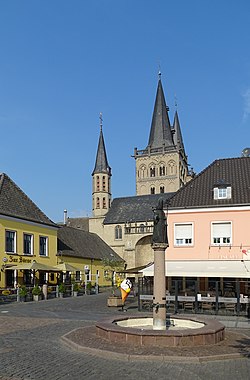You can help expand this article with text translated from the corresponding article in German. (March 2016) Click [show] for important translation instructions.
|
This article needs additional citations for verification. (January 2017) |
Xanten | |
|---|---|
 | |
Location of Xanten within Wesel district  | |
| Coordinates: 51°39′44″N 06°27′14″E / 51.66222°N 6.45389°E | |
| Country | Germany |
| State | North Rhine-Westphalia |
| Admin. region | Düsseldorf |
| District | Wesel |
| Subdivisions | 6 Stadtbezirke |
| Government | |
| • Mayor (2020–25) | Thomas Görtz[1] (CDU) |
| Area | |
• Total | 72.39 km2 (27.95 sq mi) |
| Elevation | 50 m (160 ft) |
| Population (2023-12-31)[2] | |
• Total | 21,776 |
| • Density | 300/km2 (780/sq mi) |
| Time zone | UTC+01:00 (CET) |
| • Summer (DST) | UTC+02:00 (CEST) |
| Postal codes | 46509 |
| Dialling codes | 02801 and 02804 (Marienbaum) |
| Vehicle registration | WES |
| Website | www.xanten.de |
Xanten (German pronunciation: [ˈksantn̩] , Low Rhenish: Santen) is a town in the state of North Rhine-Westphalia, Germany. It is located in the district of Wesel.
Xanten is known for the Archaeological Park, one of the largest archaeological open air museums in the world, built at the site of the Roman settlements Colonia Ulpia Traiana. Other attractions include the medieval town centre with Xanten Cathedral, many museums and large man-made lakes for various watersport activities. Xanten is visited by approximately one million tourists a year. It is also the only German town with a name that begins with X.[3]
- ^ Wahlergebnisse in NRW Kommunalwahlen 2020, Land Nordrhein-Westfalen, accessed 30 June 2021.
- ^ "Bevölkerung der Gemeinden Nordrhein-Westfalens am 31. Dezember 2023 – Fortschreibung des Bevölkerungsstandes auf Basis des Zensus vom 9. Mai 2011" (in German). Landesbetrieb Information und Technik NRW. Retrieved 2024-06-20.
- ^ German Cities — Letter X


